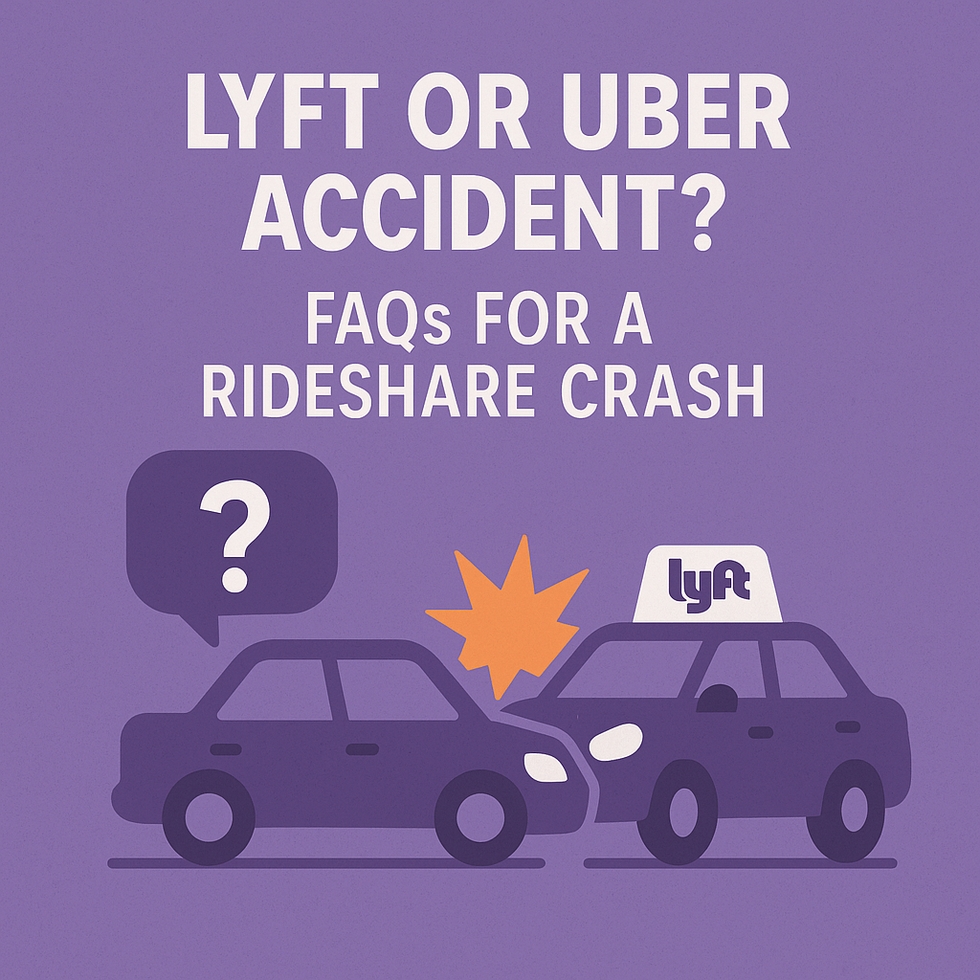
What Happens If I Was Injured in an Idaho Car Accident Involving a Rideshare Vehicle?
As rideshare services like Uber and Lyft become more popular across Idaho—including in cities like Boise, Meridian, and Coeur d’Alene—the chances of being involved in a car accident with one of these vehicles increase. But what happens if you’re injured in an accident involving a rideshare car? Whether you were a passenger, another driver, a pedestrian, or even a cyclist, understanding your rights and legal options under Idaho law is essential.
Rideshare accident claims introduce unique legal complexities, especially when it comes to determining fault and navigating multiple insurance policies. This post explains how Idaho handles rideshare-related car accidents, what insurance applies, and the practical steps you should take if you’ve been injured.
Who Can Be Involved in a Rideshare Accident?
Rideshare accidents in Idaho can involve various parties:
- Riders: Passengers inside an Uber or Lyft vehicle
- Rideshare drivers: Those operating their vehicles through the Uber or Lyft app
- Third-party drivers: Motorists who collide with or are struck by a rideshare vehicle
- Pedestrians or cyclists: Individuals hit by a rideshare car
Each category may trigger different insurance rules and legal procedures, depending on the status of the rideshare driver at the time of the accident.
The Legal Status of Rideshare Drivers in Idaho
Uber and Lyft drivers are classified as independent contractors, not employees. This means that liability doesn’t automatically fall on the company itself unless certain criteria are met. However, both companies are required to carry substantial insurance policies for their drivers when the rideshare app is active. Idaho law recognizes these corporate policies, and they often serve as the primary source of compensation—depending on the driver’s status at the time of the crash.
Understanding Rideshare Insurance Tiers
Rideshare companies provide coverage based on what the driver was doing when the accident occurred. Here’s how it breaks down:
1. Driver Offline (App Off)
If the driver is not logged into the rideshare app at the time of the accident, then only their personal auto insurance applies. Idaho law requires drivers to carry minimum liability insurance of:
- $25,000 for bodily injury per person
- $50,000 for total bodily injury per accident
- $15,000 for property damage
2. Driver Available (App On, Waiting for a Ride)
If the driver is logged into the app but has not yet accepted a ride request, Uber and Lyft provide contingent liability coverage, which includes:
- $50,000 for bodily injury per person
- $100,000 per accident
- $25,000 for property damage
This coverage only applies if the driver’s personal insurance refuses to pay or is insufficient.
3. Ride in Progress (Ride Accepted or Passenger in Car)
Once a driver accepts a ride request—or is actively transporting a passenger—Uber and Lyft provide primary commercial insurance of up to:
- $1 million in liability coverage
- Uninsured/underinsured motorist (UM/UIM) coverage
- Contingent comprehensive and collision coverage (with a deductible)
This is the most robust coverage tier and often applies in cases involving passenger injuries or collisions during active rides.
What If You’re the Rideshare Passenger?
If you’re a passenger in a rideshare vehicle and you’re injured in an accident, you’re covered under the $1 million liability policy as long as the ride was active. You can file a claim with Uber’s or Lyft’s insurer, and in some cases, with the other driver’s insurance if they were at fault.
Be aware that rideshare companies handle claims through third-party administrators, and the process can involve delays or denials without proper documentation. Prompt medical treatment, detailed records, and consistent communication are essential to getting compensated.
What If You’re Hit by a Rideshare Vehicle?
If you’re another driver, pedestrian, or cyclist hit by a rideshare car, the applicable insurance depends on the driver’s status during the crash. If the app was off, your claim will go through the driver’s personal insurance. If the app was on or the ride was in progress, you may be entitled to compensation through Uber or Lyft’s commercial coverage.
Keep in mind Idaho’s comparative negligence rule (Idaho Code § 6-801): if you are found to be 50% or more at fault, you cannot recover damages. If you’re less than 50% at fault, your compensation will be reduced by your percentage of fault.
Steps to Take After a Rideshare Accident in Idaho
Whether you’re a passenger or another party, follow these steps to protect your claim:
- Call 911 and report the accident. Request an official police report.
- Get medical attention immediately, even for minor symptoms.
- Document the scene—take photos, get witness contact info, and gather driver details.
- Confirm the rideshare status—ask the driver whether the app was active.
- Report the incident to Uber or Lyft through their app or website.
- Track medical records, lost income, and other expenses related to your injuries.
Time Limits for Filing a Claim in Idaho
In Idaho, the statute of limitations for personal injury claims—including rideshare accidents—is two years from the date of the incident (Idaho Code § 5-219). If you wait too long to file a claim or lawsuit, you may lose your right to compensation.
If a government vehicle was involved (e.g., a city bus colliding with a rideshare car), additional deadlines apply. Claims against government entities in Idaho must be filed within 180 days under the Idaho Tort Claims Act.
Final Thoughts
Accidents involving rideshare vehicles in Idaho raise complex questions about insurance coverage, liability, and legal procedures. Whether you were a passenger, a pedestrian, or another driver, it’s essential to understand how rideshare laws and insurance tiers work to ensure you’re fully compensated for your injuries.
Idaho law supports injury victims, but navigating a rideshare claim requires timely action, thorough documentation, and a clear understanding of your rights. Taking the right steps after the accident can make the difference between a fair recovery and a denied claim.

